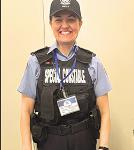 BY SEAN DELANEY
BY SEAN DELANEY.
History of a BusinessIn 1992, law enforcement put its proverbial foot down when it came to attending accident scenes. And someone had a big pair of shoes to fill.
“In 1992, the police in the province of Ontario went to the Ministry of Transportation and informed them they would no longer attend accident scenes in the province unless they involved injuries, hazardous goods, or criminal activity,” said Steve Sanderson, President of Emery’s Accident Support Services.
The police wanted to make better use of their time especially when it came to attending small fender benders. But the bottom line was an important consideration and police not attending accident scenes, even if minor in nature, was a point of anxiety for the insurance industry.
“When the insurers found out the police would not attend collisions, they panicked,” Sanderson said.
Claims would come in without a system in place to verify them.
You could have a van load of passengers all claiming back and neck injuries from a collision you wouldn’t even be able to verify,” Sanderson said. It could be a system of chaos, assumptions and half truths. It wouldn’t work well for anyone.
At the time, Sanderson was involved in the towing and repair business. He was contracted to the Toronto Police Services for North York, as well as commercial towers, dealerships, Bell Canada, Canada Post and more. 
He had a program in place with the insurance companies in Toronto and had become a trusted vendor for them. When the collision declaration came from the police, a serious opportunity knocked.
Sanderson used his connections to put together a high level executive meeting with a VP of State Farm Insurance and the Deputy Chief of Police, and the group began to brainstorm.
The ideas circulated and they came up with a drive in facility that the police would staff and supervise if the insurance providers would subsidize it.
“I offered to do the first pilot here on Toryork Dr., and that’s how we started the Collision Reporting Centre.”
The idea was unique. Government and private partnerships were relatively unheard of at the time.
“Fast forward 22 years later and having partnerships with 22 police services, including Toronto, Ontario and Alberta,”said Sanderson. “We operate 32 reporting centres, most in police stations and utilize their facilities.”
It’s a law enforcement success story that is crossing the border as well. Sanderson reported that because of the stress on law enforcement agencies, the idea is beginning to permeate to the United States.
The outlet has also created its own Collision Reporting management System, which has received a 2003 Microsoft global e-commerce award, a 2005 Microsoft impact award for the analytics piece the company created through it, and in 2013 an insurance Canada IT supplier award.
“Collisions take place and we capture them electronically,” Sanderson explained. 
When you report a collision, one of Sanderson’s staff will interview you, a process that fills a provincial form with 266 questions. The information is shared with road engineers, insurers, police and the ministry of transportation. All who can stylize the data and react in their own way to mitigate further collisions.
“Everyone knows the hot spots, but why are they happening?” Sanderson said.
Once they determine where they are, why they’re happening, the police can do proactive programs to have the proactive effect of reducing accidents. The Province can instill infrastructure to calm the effects. Etc.
“We’ve really hit a home run in terms of road safety, to allow police, who are interested in making roads safer, an opportunity to do it. Just by digging into this information and using it,” Sanderson said. “It’s a real success story.”
And in a decisive swipe, they proved the benefits of the program. Sanderson explained that before his centres were around photographing and recording every detail, auto body shops would frequently add repairs that were not consistent with the collisions, upping the costs, their profits, and basically performing fraud.
That $15 million a year problem, was almost immediately wiped out.
A history with the BIA:
Sanderson is a founding member of the Emery Village BIA, and a proud supporter of the work done by the organization. What is interesting is the roots of the business group.
“The BIA is just a fantastic thing as far as I’m concerned, he said.“If you look at what they accomplished during the past 12 years, it started off as let’s deal with the water issue in Emery creek and all the pollution.”Sanderson said on a Wednesday the creek waters would run blood red on a Friday, blue as someone’s eyes the next day, and then Tuesday, maybe yellow.
“It was clear some business was dumping chemicals into their storm sewers likely, and they were finding their way into the creek.”
So a group of business leaders, including Sanderson, put their heads and collective wits together, and formed the Emery Village BIA. As it evolved, it became a business improvement area and they needed to brand it.
They hired a firm and began to focus on benches, flowers, establishing a gateway to the area, and bringing the community together with successful community events.
“If you look at the executive every spring, we have maintained that,” Sanderson said.
And in the next year, the group will continue to push its flagship idea, Canada’s largest flagpole.
The 385 foot tourist attraction would be the signature feature of the area, an educational outlet, and an accomplishment that would cement Emery Village on the map.“I just think it would be fantastic,” he said.
History of a local icon:Steve Sanderson’s wife Margaret is worthy of more than just a note, but we offer one anyway to remember the Emery Village icon.
The pair began their business, originally a towing and storage business in 1976. Margaret Kemp and Steve began with one truck, G+S towing, at Jane and Steeles.
“Maggie was instrumental in building and growing the business,” Steve said. In 1983, they made the move to Toryork and began establishing themselves as part of their neighbourhood.
“She was so well known in the area. She gave so many immigrants their first job, she had a soft spot for single parents, and she was always the first to give anyone a chance.”Margaret passed away in June of 2006.
The business community began a charity in her honour that has raised more than $100,000 in donations. The money was recently donated on her behalf to the new Humber River Hospital, Sanderson said. “Maggie would be so proud to see where we continue to take the neighborhood, the one that she so much loved called Emery”
Accident Support Services International Ltd.111 – 113 Toryork Dr. (877) 895-9111














